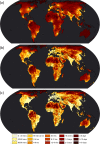A suite of global accessibility indicators
- PMID: 31700070
- PMCID: PMC6838165
- DOI: 10.1038/s41597-019-0265-5
A suite of global accessibility indicators
Abstract
Good access to resources and opportunities is essential for sustainable development. Improving access, especially in rural areas, requires useful measures of current access to the locations where these resources and opportunities are found. Recent work has developed a global map of travel times to cities with more than 50,000 people in the year 2015. However, the provision of resources and opportunities will differ across the broad spectrum of settlements that range from small towns to megacities, and access to this spectrum of settlement sizes should also be measured. Here we present a suite of nine global travel-time accessibility indicators for the year 2015, at approximately one-kilometre spatial resolution, for a range of settlement size classes. We validated the travel-time estimates against journey times from a Google driving directions application across 1,511 2° × 2° tiles representing 47,812 journeys. We observed very good agreement, though our estimates were more frequently shorter than those from the Google application with a median difference of -13.7 minutes and a median percentage difference of -16.9%.
Conflict of interest statement
The authors declare no competing interests.
Figures



References
-
- Velaga NR, Beecroft M, Nelson JD, Corsar D, Edwards P. Transport poverty meets the digital divide: Accessibility and connectivity in rural communities. J. Transp. Geogr. 2012;21:102–112. doi: 10.1016/j.jtrangeo.2011.12.005. - DOI
-
- Shiferaw B, Hellin J, Muricho G. Improving market access and agricultural productivity growth in Africa: What role for producer organizations and collective action institutions? Food Secur. 2011;3:475–489. doi: 10.1007/s12571-011-0153-0. - DOI
-
- Schmit TM, Gómez MI. Developing viable farmers markets in rural communities: An investigation of vendor performance using objective and subjective valuations. Food Policy. 2011;36:119–127. doi: 10.1016/j.foodpol.2010.10.001. - DOI
-
- Schmitz C, et al. Trading more food: Implications for land use, greenhouse gas emissions, and the food system. Glob. Environ. Chang. 2012;22:189–209. doi: 10.1016/j.gloenvcha.2011.09.013. - DOI
Publication types
LinkOut - more resources
Full Text Sources

